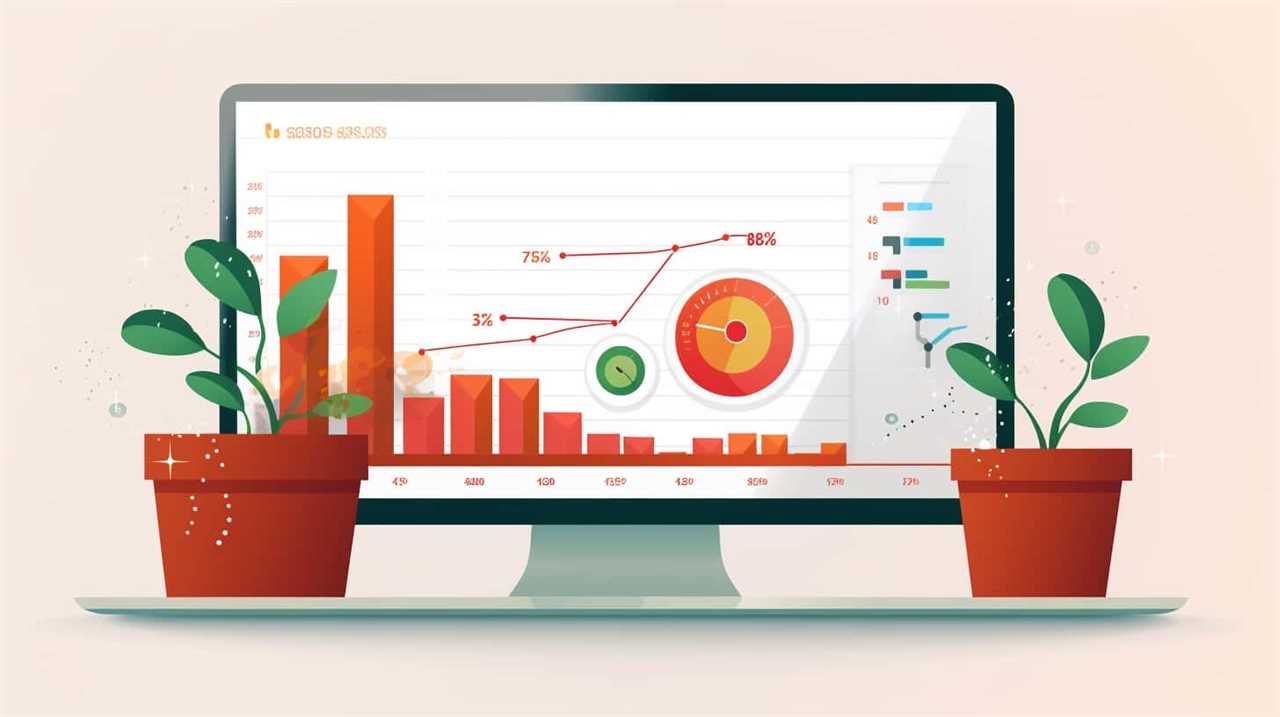Tired of your website not making the cut in search rankings? Stress no more! The perfect fix awaits you.
In this article, we will guide you through a step-by-step process to give your website a complete SEO overhaul.
From conducting keyword research to building high-quality backlinks, we’ve got you covered.
So, fasten your seatbelts and get ready to take your website to the top of the search results!

Key Takeaways
- Keyword research and on-page optimization are essential for attracting targeted traffic and improving search engine rankings.
- Optimizing meta tags, including the title tag, meta description, and meta keywords, can significantly improve click-through rates and organic traffic.
- Optimizing website loading speed through various techniques such as minimizing HTTP requests, compressing files, and utilizing caching can enhance user experience and SEO performance.
- Creating high-quality and relevant content, regularly updating it, and building high-quality backlinks are crucial for SEO optimization and increasing organic traffic.
Conduct Keyword Research
First, we regularly conduct keyword research to ensure our website is fully optimized for search engines. Keyword research is the foundation of any successful SEO strategy. By identifying the right keywords, we can attract targeted traffic to our website and increase our visibility in search engine results pages (SERPs).
One aspect of keyword research is determining the optimal keyword density for our content. Keyword density refers to the percentage of times a keyword appears in relation to the total number of words on a page. It’s important to strike a balance between using keywords enough to signal relevance to search engines, but not so much that it appears spammy to users.
Another important factor in keyword research is on-page optimization. This involves optimizing various elements on our website, such as meta tags, headings, and URLs, to include relevant keywords. By doing so, we can increase the chances of our webpages ranking higher in SERPs.
Analyze and Optimize Meta Tags
Now let’s talk about the importance of meta tags and how to optimize them for better SEO results.

Meta tags play a crucial role in telling search engines what your website is about.
By optimizing your meta descriptions, you can improve your click-through rates and attract more organic traffic.
Meta Tag Importance
To fully optimize our website, we must analyze and optimize the meta tags by using a comprehensive approach. Meta tags play a crucial role in search engine optimization (SEO) as they provide information about the content of a webpage. By understanding the importance of meta tags and implementing meta tag best practices, we can improve our website’s visibility and attract more organic traffic.
When optimizing meta tags, it is essential to focus on key elements such as the title tag, meta description, and meta keywords. The table below outlines the significance of each meta tag and provides recommendations for optimization:

| Meta Tag | Importance | Optimization Tips |
|---|---|---|
| Title Tag | High | Include relevant keywords, keep it concise (around 50-60 characters) |
| Meta Description | Medium | Write persuasive and informative descriptions (around 150-160 characters) |
| Meta Keywords | Low | Choose relevant keywords, but avoid keyword stuffing |
Optimizing Meta Descriptions
One crucial step in optimizing meta tags is to analyze and optimize meta descriptions, which play a significant role in improving a website’s visibility and driving organic traffic.
When it comes to optimizing meta descriptions, there are two key factors to consider: keyword placement and meta tag length.
To optimize keyword placement in your meta descriptions, it’s essential to strategically place relevant keywords near the beginning of the description. This helps search engines understand the content of your page and improves the chances of your website appearing in relevant search results.
In addition to keyword placement, meta tag length is also important. Ideally, meta descriptions should be between 50-160 characters long to ensure they’re displayed properly in search engine results pages (SERPs). Keeping your meta descriptions concise and informative will help entice users to click on your website.

Improve Website Loading Speed
We can enhance our website’s loading speed by implementing various optimization techniques.
One of the first steps to improve website loading speed is to focus on improving website design. A well-designed website with clean and efficient code can significantly reduce loading times.
By optimizing the HTML, CSS, and JavaScript files, we can minimize HTTP requests and improve the overall performance of our website. This can be achieved by combining multiple files into one, reducing the file size by removing unnecessary code, and utilizing caching techniques.
Additionally, optimizing images by compressing them without compromising quality can also help to improve loading speed.

Enhance User Experience and Navigation
After improving the website’s loading speed, it’s important to enhance user experience and navigation. This step is crucial to keep visitors engaged and encourage them to stay longer on your site. Here are three key strategies to achieve this:
- Improve Accessibility: Ensure that your website is accessible to all users, including those with disabilities. Use alt text for images, provide captions for videos, and optimize your site for screen readers.
- Mobile Optimization: With the increasing use of smartphones, it’s essential to optimize your website for mobile devices. Make sure your site is responsive and loads quickly on mobile devices.
- Streamline Navigation: Simplify your website’s navigation by organizing content logically and using clear and intuitive menus. Implement a search function to help users find what they need quickly.
Create High-Quality and Relevant Content
When it comes to optimizing our website for SEO, creating high-quality and relevant content is crucial. By ensuring that our content is relevant to our target audience and optimized with the right techniques, we can greatly improve our search engine rankings.
Not only does quality content attract more organic traffic, but it also helps establish our website as a reliable source of information, ultimately benefiting our SEO efforts.
Importance of Relevancy
Creating high-quality and relevant content is essential for optimizing a website’s SEO. In today’s competitive online landscape, search engines prioritize websites that offer valuable and pertinent information to users. Here are three reasons why relevance plays a crucial role in SEO success:

- Relevance vs. Authority: While authority is important, relevance is equally significant. Striking the right balance between the two is key to achieving SEO success.
- The Role of Relevance in SEO: Relevance is a determining factor in search engine rankings. By creating targeted content that aligns with user intent, you increase your chances of ranking higher.
- Rank Higher with Targeted Content: By understanding your target audience and their needs, you can create content that directly addresses their pain points, increasing engagement and driving organic traffic.
By creating high-quality and relevant content, you not only improve your website’s SEO but also enhance the user experience.
In the next section, we’ll explore effective content optimization techniques to further boost your website’s performance.
Content Optimization Techniques
To optimize our website’s content, we employ effective techniques that focus on creating high-quality and relevant information. One crucial aspect of content optimization is content formatting. By structuring our content using headings, subheadings, bullet points, and numbered lists, we make it easier for both users and search engines to understand and navigate our content.
Additionally, we incorporate link building strategies into our content optimization efforts. By including relevant and authoritative links within our content, we not only provide valuable resources to our readers but also improve our website’s credibility and visibility in search engine rankings.

These techniques are essential for creating content that engages our audience and meets their needs. By optimizing our content, we can achieve higher rankings, increased organic traffic, and ultimately, better SEO results.
Now, let’s delve into the SEO benefits of quality content.
SEO Benefits of Quality Content
We achieve higher rankings, increased organic traffic, and better SEO results through the creation of high-quality and relevant content.
Content relevance is crucial when aligning your SEO strategy with your target audience. By understanding the needs and interests of your audience, you can create content that resonates with them and drives more traffic to your website.

Quality content has a significant impact on user engagement and conversion rates. When your content is informative, engaging, and valuable to your audience, they’re more likely to spend time on your website, interact with your content, and ultimately convert into customers. This not only improves your SEO rankings but also increases the chances of achieving your business goals.
As we move forward, let’s explore how to optimize images and multimedia to further enhance your website’s SEO performance.
Optimize Images and Multimedia
Our goal is to optimize all images and multimedia elements on our website to enhance its overall SEO performance.
Image optimization techniques are crucial for improving website speed and user experience, which are both important factors in search engine rankings. By compressing multimedia files, we can reduce their file sizes without sacrificing quality, resulting in faster loading times and improved website performance.

There are several image optimization techniques we can implement, such as reducing image dimensions, using the correct file format, and optimizing alt text and file names.
Additionally, multimedia file compression can be achieved through various methods, such as using efficient codecs, adjusting bitrates, and optimizing audio and video formats.
Build High-Quality Backlinks
One essential step in our SEO content overhaul is to acquire a sufficient number of high-quality backlinks. Building high-quality backlinks is crucial for improving your website’s visibility and ranking on search engine results pages.
Here are three effective link building strategies to consider:

- Guest blogging: Publishing high-quality articles on reputable websites in your industry can help you build backlinks and establish your expertise.
- Broken link building: Identify broken links on authoritative websites and offer your own content as a replacement, earning a valuable backlink in return.
- Influencer outreach: Reach out to influential individuals or brands in your niche and collaborate on content or partnerships, which can result in valuable backlinks.
These link building strategies, when executed with effective outreach, can significantly boost your website’s authority and improve its search engine rankings.
Frequently Asked Questions
How Do I Choose the Right Keywords for My Website?
When choosing the right keywords for our website, we focus on thorough keyword research. This is an essential step in crafting an effective SEO strategy that will drive targeted traffic to our site.
What Are Meta Tags and Why Are They Important for Seo?
Meta tags are vital for SEO. They provide information about a webpage to search engines. Meta tag optimization involves writing compelling meta descriptions, which can significantly improve click-through rates and increase organic traffic to your website.
How Can I Improve the Loading Speed of My Website?
To improve website performance, we optimize website images and enhance loading speed. Like a race car on a smooth track, we fine-tune our website to ensure it loads lightning fast for a superior user experience.

What Are Some Ways to Enhance User Experience and Navigation on My Website?
Enhancing user experience and navigation on your website is crucial. Incorporating website design trends and ensuring mobile optimization are key ways to achieve this. Our team can guide you through these steps for a fully optimized website.
How Do I Create High-Quality and Relevant Content for My Website?
To create high-quality and relevant content for our website, we focus on creating engaging content that resonates with our audience. We also optimize our website structure to ensure easy navigation and accessibility for our users.
Conclusion
After following these seven steps to optimize your website, you can expect to see significant improvements in your online visibility and user engagement.
- Conduct thorough keyword research.
- Optimize meta tags.
- Improve loading speed.
- Enhance user experience.
- Create high-quality content.
- Optimize images and multimedia.
- Build high-quality backlinks.
By completing each of these steps, your website will be fully optimized for search engines and user satisfaction.

Keep investigating and refining your SEO strategy to stay ahead of the competition and continuously improve your website’s performance.









